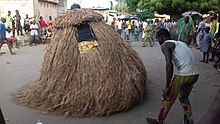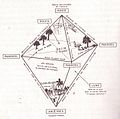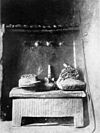Introduction The beliefs and practices of African people are highly diverse, including various ethnic religions. Generally, these traditions are oral rather than scriptural and are passed down from one generation to another through folk tales, songs, and festivals, and include beliefs in spirits and higher and lower gods, sometimes including a supreme being, as well as the veneration of the dead, and use of magic and traditional African medicine. Most religions can be described as animistic with various polytheistic and pantheistic aspects. The role of humanity is generally seen as one of harmonizing nature with the supernatural. (Full article...) Selected articleIfá is a Yoruba religion and system of divination. Its literary corpus is the Odu Ifá. Orunmila is identified as the Grand Priest, as he is who revealed divinity and prophecy to the world. Babalawos or Iyanifas use either the divining chain known as Opele, or the sacred palm or kola nuts called Ikin, on the wooden divination tray called Opon Ifá. Ifá is practiced throughout the Americas, West Africa, and the Canary Islands, in the form of a complex religious system, and plays a critical role in the traditions of Santería, Candomblé, Palo, Umbanda, Vodou, and other Afro-American faiths, as well as in some traditional African religions. Selected imagesFestivalsThere are several religious festivals found in the various Traditional African religions. Some of these are listed below next to their corresponding religion :
Selected biographyBabacar Sedikh Diouf (Serer: Babakar Sidiix Juuf) is a Senegalese historian, author, researcher, campaigner against "Wolofization", a Pan-Africanist, and former teacher. He has written extensively about the history and culture of Senegal, Africa, and that of the Serer ethnic group to which he belong. He usually writes by the pen name Babacar Sedikh Diouf. Diouf was one of the first (if not the first) to explain the Serer religious significance of the Senegambian stone circles. His work published on July 7, 1980 on the Senegalese newspaper Le Soleil became headline news and was picked up by the prehistorian and archaeologist Professor Cyr Descamps and his colleague Professor Iba Der Thiam. Professor Descamps was one of the archaelogisgts who excavated the monuments back in the 1970s. On July 28, 1980, Professor Descamps issued a response to Diouf—thanking him for explaining the significance of the Senegambian megaliths which until then were unknown or undocumented. Some of that included the arrangement of the stones and their religious symbolism based on Serer numerlogy. In his joint paper with Iba Der Thiam – titled: La préhistoire au Sénégal: recueil de documents, published in 1982, Descamps and Thiam republished Diouf's work and reiterated their thanks to him for his work two years earlier. Selected quote
Ram Swarup quoted in Koenraad Elst (2002) Source: Swarup, Ram [in] Elst, Koenraad, Who is a Hindu? : Hindu Revivalist Views of Animism, Buddhism, Sikhism, and Other Offshoots of Hinduism, Voice of India (2002), p. 72, ISBN 9788185990743
Did you know
Related portalsTopicsFor more Traditional African religion topics, see Category:Traditional African religions.
CategoriesWikiProjectsThings you can doAssociated WikimediaThe following Wikimedia Foundation sister projects provide more on this subject:
Discover Wikipedia using portals
Purge server cache
|




































